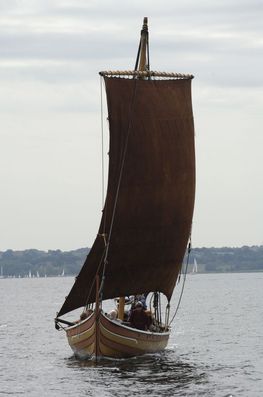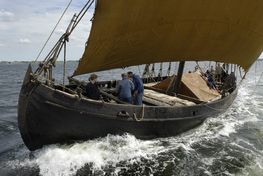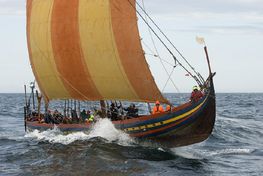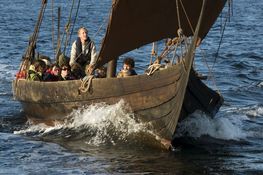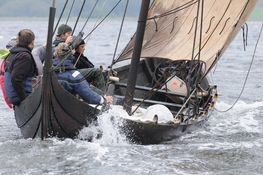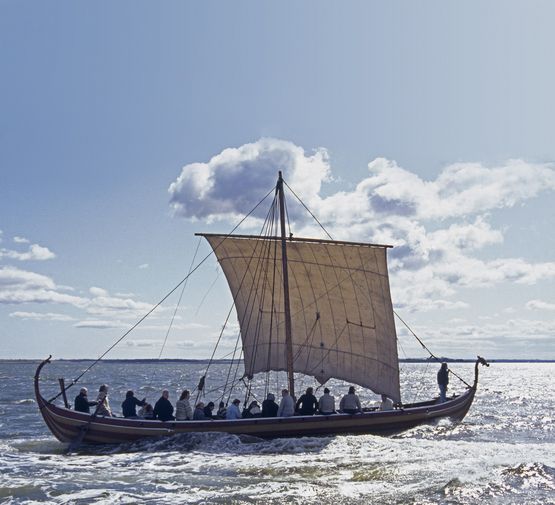
Standardised sailing and rowing trials
Standardised sailing and rowing trials take place either in enclosed waters such as, for example, in the broader sections of fjords or in more open waters, according to whether the ship under trial is seen as having been created for voyages in relatively sheltered waters or for the open sea. The work is carried out from a base harbour but it is important to perform the experiments in different weather conditions and that the individual experiments are repeated as often as circumstances allow in order to increase the value of the data gathered. In other words: Once is not at all! Furthermore, natural conditions change constantly with regard to the immediate wind force, wind direction and wave formation. All these variants must be carefully recorded, at the same time as sailing as much as possible on different courses relative to the main wind direction in order to test the ship’s properties of speed and manoeuvring as well as seaworthiness.
The results of the measurements make it possible to make statements concerning the capabilities of the original Viking ships under different weather conditions and with different loading/cargo circumstances. The trial voyages with Helge Ask, which is a full-scale reconstruction of the small 18m long warship Skuldelev 5, have shown that on average a speed of about 5-6 knots can be maintained over a longer period if the wind during this period has a strength of between 5 and 10 m/s (Force 3-5 Bft) and comes in from the side or diagonally from abaft. Therefore it is possible, even though Helge Ask has not yet sailed this voyage, to conclude that the 235 nautical miles across the Kattegat, from Roskilde to a Viking marketplace in Oslo Fjord by the name of Kaupang, could be travelled in just under 50 hours in a ship of this type, if the wind held stable from the west or southwest during this time. Conversely, the trial voyages show that the same ship would have difficulties in making the same voyage under sail in a strong northerly wind. Tacking against the wind would at best give a speed of 2 knots in a northerly direction. However, if the northern wind became light it would be possible to row the ship with a speed of 3.5-4 knots.
Besides describing the performance of the individual ships, the data gathered will, as far as possible, also be compared with data from other ships from the same or other periods which have been trialled under similar circumstances.
The first trial voyages
The first trial voyages under the auspices of the Viking Ship Museum took place as early as 1976 and 1977. The museum’s original square sail rigged Nordland fishing vessel Rana from about 1892 became the subject of a long series of voyages in the broad outer part of Roskilde Fjord, north of Elleore. The experimental method and the results are described in: Nordlandsbåden – analyseret af prøvesejlet af Vikingeskibshallens Bådelaug. Working papers 12. The National Museum of Denmark, København 1980.
In 1984 and 1985 trial voyages were carried out with the Viking Ship Museum’s first reconstruction of the best preserved ship from the Skuldelev site – the small merchant ship Skuldelev 3. Roar Ege was tested in the outer part of Isefjord and in the entrance to the fjord off Hundested. The ship was equipped with comprehensive and bulky electronic measuring equipment based on the then Decca system. The results are published in: Roar Ege – Skuldelev 3 skibet som arkæologisk eksperiment af Erik Andersen, Ole Crumlin Petersen, Søren Vadstrup & Max Vinner. Vikingeskibshallen i Roskilde 1997.
Helge Ask, the sailing reconstruction of Skuldelev 5 – the small 18 m warship – was thoroughly tested in the outer part of Roskilde Fjord in 1992 under almost all weather conditions and both rowed and under sail. A brief report is given in Roar and Helge af Roskilde – om at bygge og sejle med vikingeskibe by Ole Crumlin-Pedersen and Max Vinner (Nationalmuseets Arbejdsmark 1993, 11-29, English summary). A much more detailed account of the experiments and the experimental set up will appear in the large book on the Skuldelev finds The Skuldelev Ships in the Viking Ship Museum’s monograph series Ships and Boats of the North. Volume I, which is the archaeological part, was published in 2003, whereas volumes II and III, which comprise respectively the building of, and sailing with, the five Skuldelev ships, are expected to be published in a few years' time.
Ottar (Skuldelev 1) the 16 m seagoing knarr, was tested in the autumn of 2003 in the southern part of the Kattegat with Hundested as the base harbour. In the week of the trials there were fortunately near gale-force conditions, requiring a full two ropes in the sail of this otherwise very stable ship, as well as more 'pleasant' weather in which a full sail was almost too little canvas. Ottar sailed amazingly well under all the test conditions. The results are still being processed but they will, together with the trial data from the other Skuldelev ships, be published in The Skuldelev Ships II & III.
The most recent sailing trials took place, when the Sea Stallion from Glendalough (Skuldelev 2) sailed to Dublin via the Orkney Islands and Scotland in 2007, and returned to Roskilde through the English Channel in 2008. En route, various sailing trials were carried out. The data of these are still being analysed and will be published in due course.
